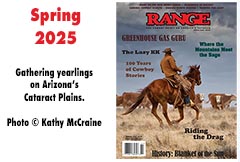

 |
 |
|
THE HUMBLE BUT IMPORTANT COW PIE The Tao and Ecology of Poo and the Key Role of Endangered Feces. By
Steven H.
Rich
Ecologically, good, clean, high-quality organic cow dung is great stuff. When itâs full of life (beetles, larvae, worms, bacteria, fungi), itâs a thing of beauty. Birds love cow dung. They eat the seeds, bugs, larvae and worms in it, and some of the dung itself. Mice, voles and other rodents tear it apart just like the birds, looking for nutritious morsels. Reptiles stake out hunting territories around it. Reptile herbivores like desert tortoises eat the dung for easy calories and B vitamins. Curlews probe for vermiform and insect lunches under cow pies (or buffalo chips) with curved bills precisely adapted for that purpose. Cow dung is a fountain of food÷a banquet of delights. It provides moisture, sustenance and shelter for a long list of creatures that support another very long list. Cow pies support the soil food web in many ways. As a response to rain and snowmelt, dried dung provides many batches of high quality compost tea, carrying with it readily available nutrients and micro-organic inoculants. Fungi reach white mycelic tendrils out of the ground to suck enzyme-dissolved carbohydrates and other goodies into the soil. Cow pies are nectar and ambrosia to dung beetles that hugely improve soils and do all that work for÷dung! These beetles have exquisitely sensitive dung detectors. A fresh deposit leaves a spreading plume of delectable odors that the beetles can sense in tiny parts per billion. These sturdy fliers rise into the softly scented air, vectoring on increasing concentration until they arrive (plop!) at the prize. There are three basic strategies for dung beetles originally adapted to bison droppings. Some species burrow right into the pie and build an elaborate tracery of tunnels. They lay eggs that quickly hatch into some of the larvae so prized as juicy delicacies by carnivorous species. Other dung beetles, sometimes called tumblebugs, grab a chunk which forms into a ball as they roll it away to an excavation where it is sealed in and adorned with eggs. The eggs hatch, feed on the dung, and soon mature to seek a pile of their own. The final strategy is to tunnel into soil under the protective cover of the pie, laying eggs to be nourished by plugs of poop deposited by hardworking parents who loosen, fertilize, and aerate soils in the process, as the tumblebugs do. My friends Dr. Pat Richardson (the Dung Beetle Lady) and her husband Dr. Dick Richardson (both of the University of Texas at Austin, Department of Integrative Biology) made me a connoisseur of cow pies. I prod them, sniff them, turn them over, open and examine them. They speak volumes about the health of the land. I once counted 17 species of insects visiting an Idaho cow pie in a four- or five-minute period. There were butterflies, wasps, bees, beetles, moths, flies, hornets, dragonflies, lacewings and a mantis. Ecologically, dung is a big deal. But itâs also the number one anti-livestock issue. Why do some people hate it (except the traumatic-botched-potty-training-leading-to-anal-retentive-personalities theory)? Healthy landscapes have for centuries on end received the dung of many species, processed it, and given it back as new life. Cow pies can disappear into the soil in a single day where there are lots of dung beetles. Remember that the sacred Egyptian scarab, a symbol of rebirth, is a dung beetle. Good cow pies have little odor. Feedlots and dairies have many times the odor of rangeland corrals because of the rich diets confined cattle get from feed mangers. Rangeland pastures smell like grass and flowers. Unfortunately, some anal retentives in the federal government buy into the Eurocentric, anthropocentric, urban-elite-centered prejudice against manure. For example, page 25 of Environmental Assessment Number UT-030-02-001, prepared by Grand Staircase/ Escalante National Monument staffers, recommends the complete de-stocking of an allotment, stating: ăprimary recreation activities would continue. However, as a result of removing cattle from the allotment, the quality of these experiences would improve. Improvements in quality would include visitors not being exposed to cattle, their sign (i.e., feces, tracks and trails), and associated odors.ä It goes on to list another quarter-page of anti-livestock mythology based on an esthetic no meadowlark, pronghorn or horned lizard would recognize. It reiterates a favorite fable anti-livestock activists like to throw into documents, The Devastating Dung Fire Risk (Which Must Be Prevented At All Costs): ăOsborn, et al. (1987) also noted that dried dung accumulations can catch fire, potentially destroying any organic artifacts or remains.ä Of course, any artifacts are millions of times more likely to be exposed to bonfires built by hikers in these locations, but somehow that escapes the authorsâ mention. Come on people, lighten up! Buffalo chips and cow pies are indispensable, integral parts of the West. Most people love to see cowboys and cows together. They stop and wave. They smile. They take pictures. They want to pose with them. The cows (and the pies) donât deter them at all. Cow pies are part of what Dr. Samuel McNaughten of Syracuse University calls the ăgrazing lawnä phenomenon. An enriched soil grows extra-nutritious plants with increased grazing tolerance and a much longer green, active period. Wildlife needs these grazing lawn communities. Livestock form and maintain them. When you see cow pies, pray theyâre full of life. An early British naturalist stated that God must be extraordinarily fond of beetles because he created zillions of varieties. And look what he gave so many species of them to eat. Learn to love and appreciate healthy, life-giving dung. And as for that potty training thing÷get over it.
Steven H. Rich is president of Rangeland Restoration Academy in Salt Lake City. For more information and Web sites of the scientists cited, contact Steve at steve@rangelandrestoration.com.
Dung beetles are vital actors in the balance and harmony of nature. Photo © Joe McDonald, Tom Stack & Associates
|